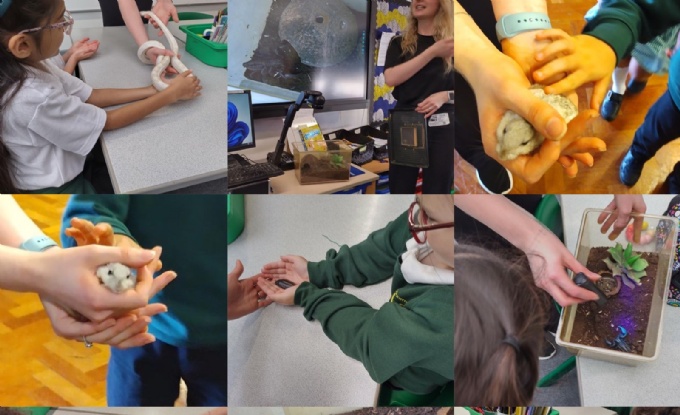Zoolab visit

Today we had a visit from Lily at Zoolab to link with our theme unit ‘Amazing Animals’.
The first of her animal guests she bought to show us were 2 snails – Harvey and Pierre. They have 2 eyes and 2 noses but 10,000 teeth on their tongue! They eat plants by licking it! Snails have no bones. We also found out that whatever colour food snails eat, they poo the same colours! When they are full grown they will be the size of a football.
Everyone in year 3 had the opportunity to interact with the animals. There were different actions we were taught so that we could all interact to a level we felt comfortable with. Most of the children went out of their comfort zones and held the animals.
- Flat hands = hold
- One finger = stroke
- Wave = no thank you, I don’t want to hold the animal
The second animal we met was called a Madagascar hissing cockroach called Joan. However, she didn’t hiss at us because she wasn’t scared and she wasn’t trying to communicate with other cockroaches. She had 6 legs and mandibles to tear her food. A cockroach is an omnivore and detritivore - it eats grass, plants, fruit, vegetables... However, she would also eat human food like pizza or even stinky socks or poo (and other rotting things)! They eat EVERYTHING. Cockroaches have no bones but she had a hard outside which means she is an exoskeleton. We learned how amazing cockroaches really are… She can hold her breath underwater for an hour, survive in a freezer for a whole year or even survive without her head for a week! She had 2 antennae which are her feelers.
The third animal had 8 legs, 2 pinchers and a sting with venom in his tail. It was an arachnid, an Asian Forest Scorpion, called Hurricane. Because of his venom, we didn’t hold this one. A scorpion also had an exoskeleton and this can glow a pretty blue colour. When scientists don’t know the answer to something, they call it a theory. The theory with the scorpions glow is that it looks like a colourful flower. This will then attract a bee and then eat it when it comes close. This saves energy as it would not need to chase them. He would use his pincers to grab and squash his food. The children asked Lilly how she cleans out the box without getting stung. Lilly said that she moves him to another box whilst she does this. Scorpions can have up to 12 eyes but they cannot turn their heads, they can only look forwards.
The fourth animal we got to meet had 200 legs. It was a Giant African Train Millipede called Micky which is different to a centipede because it has more legs. Most millipedes have anywhere from 102 legs to 1000. When Micky was born he had 6 legs and he grows legs as he grows. He will probably be the length of a school ruler when he is fully grown. Every time they get new legs they have to shed all of their skin. This is because they have a hard outside (exoskeleton) where the legs cannot grow through. Micky tapped his antenna along our hands as he walked along so that he didn’t bump into anything. Birds would eat millipedes but millipedes have a good defence mechanism – to curl up really small and let go of a really bad smelling yellow liquid. This means the birds will not want to eat him. We also found that Millipedes are detritivores and they lay eggs.
The final animal we met on this visit we had to be very quiet for – a snake called Migini - a white/yellow cornsnake which is a constrictor. This means that they strangle their prey before eating it. It has 500 bones (more than a human with 206 bones). It also has 15,000 muscles (way more than a human with 800 muscles). The children had to be really careful handling the snake as she didn’t want to be poked or squeezed. When snakes stick their tongue out, they are smelling but when they eat their meals, they open their mouths really wide and swallow them whole. She was a carnivore.
After each class had their Zoolab workshop, we all went to the hall where we eventually met our final animal of the visit. First, we first had a recap of all the science learning around each animal where the teachers bravely held each one. The children were also able to ask any questions they still had not had answered.
When the time came, we met a small, fluffy/furry animal. This one was not a minibeast but a warm blooded mammal – a gerbil called Juniper. She is an omnivore which means she eats plants and meats (little bugs/crickets). She comes from Mongolia and would usually live in the dessert. Her fur is waterproof. Her front feet are really strong so that she can dig under the sand when it gets too hot. The gerbil is able to lose their tail and grow it back in case they are caught by the tail. She has little muscles on the base of her bottom which would let go of the tail. If she had lost her tail, it wouldn’t grow back with fur but would be scarred and scabby. This means that she has been well looked after. She also has whiskers for sensing.
The children were all able to stroke Juniper. They were so respectful during the visit and asked such thoughtful questions.
